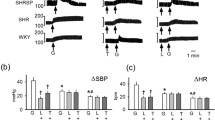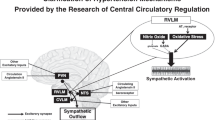Abstract
Increased blood pressure (BP) in genetic hypertension is usually caused by high activity of sympathetic nervous system (SNS) which is enhanced by central angiotensin II but lowered by central nitric oxide (NO). We have therefore evaluated NO synthase (NOS) activity as well as neuronal NOS (nNOS), inducible NOS (iNOS) and endothelial NOS (eNOS) protein expression in brainstem and midbrain of adult spontaneously hypertensive rats (SHR) characterized by enhanced sympathetic vasoconstriction. We also studied possible participation of brain NO in antihypertensive effects of chronic captopril treatment of adult SHR. NOS activity was increased in midbrain of SHR compared to Wistar-Kyoto (WKY) rats. This could be ascribed to enhanced iNOS expression, whereas nNOS expression was unchanged and eNOS expression was reduced in this brain region. In contrast, no significant changes of NOS activity were found in brainstem of SHR in which nNOS and iNOS expression was unchanged, but eNOS expression was increased. Chronic captopril administration lowered BP of adult SHR mainly by attenuation of sympathetic tone, whereas the reduction of angiotensin II-dependent vasoconstriction and the decrease of residual BP (amelioration of structural remodeling of resistance vessels) were less important. This treatment did not affect significantly either NOS activity or expression of any NOS isoform in the two brain regions. Our data do not support the hypothesis that altered brain NO formation contributes to sympathetic hyperactivity and high BP of adult SHR with established hypertension.
Similar content being viewed by others
References
Bredt DS, Snyder SH (1990) Isolation of nitric oxide synthetase, a calmodulin-requiring enzyme. Proc Natl Acad Sci USA 87:682–685
Schuman EM, Madison DV (1994) Nitric oxide and synaptic function. Annu Rev Neurosci 17:153–183
Vincent SR, Kimura H (1992) Histochemical mapping of nitric oxide synthase in the rat brain. Neuroscience 46:755–784
Krukoff TL (1998) Central regulation of autonomic function: NO brakes? Clin Exp Pharmacol Physiol 25:474–478
Leenen FHH, Ruzicka M, Huang BS (2002) The brain, salt-sensitive hypertension. Curr Hypertens Rep 4:129–135
Ramchandra R, Barrett CJ, Malpas SC (2005) Nitric oxide and sympathetic nerve activity in the control of blood pressure. Clin Exp Pharmacol Physiol 32:440–446
Ganten D, Speck G (1978) The brain rennin–angiotensin system: a model for the synthesis of peptides in the brain. Biochem Pharmacol 27:2379–2389
Brody MJ, Fink GD, Buggy J, Haywood JR, Gordon FJ, Johnson AK (1978) The role of the anteroventral third ventricle (AV3V) region in experimental hypertension. Circ Res 43(Suppl I):I2-I13
Osborn JW (2005) Hypothesis: set-points and long-term control of arterial pressure. A theoretical argument for a long-term arterial pressure control system in the brain rather than the kidney. Clin Exp Pharmacol Physiol 32:384–393
Allen AM (2002) Inhibition of the hypothalamic paraventricular nucleus in spontaneously hypertensive rats dramatically reduces sympathetic vasomotor tone. Hypertension 39:275–280
Ito S, Komatsu K, Tsukamoto K, Kanmatsuse K, Sved AF (2002) Ventrolateral medulla AT1 receptors support blood pressure in hypertensive rats. Hypertension 40:552–559
Ferguson AV (1988) Paraventricular nucleus neurons projecting to the dorsomedial medulla are influenced by systemic angiotensin. Brain Res Bull 20:197–201
Ferguson AV, Bains JS (1997) Actions of angiotensin in the subfornical organ and area postrema: implications for long term control of autonomic output. Clin Exp Pharmacol Physiol 24:96–101
Wright JW, Harding JW (1992) Regulatory role of brain angiotensins in the control of physiological and behavioral responses. Brain Res Rev 17:227–262
Veerasingham SJ, Raizada MK (2003) Brain rennin–angiotensin system dysfunction in hypertension: recent advances and perspectives. Br J Pharmacol 139:191–202
De Jonge A, Knape JT, van Meel JC, Kalkman HO, Wilffert B, Thoolen MJ, Van Brummelen P, Timmermanns PB, van Zwieten PA (1983) Effect of captopril on sympathetic neurotransmission in pithed normotensive rats. Eur J Pharmacol 88:231–240
Balt JC, Mathy MJ, Pfaffendorf M, van Zwieten PA (2001) Inhibition of angiotensin II-induced facilitation of sympathetic neurotransmission in the pithed rat: a comparison between losartan, irbesartan, telmisartan, and captopril. J Hypertens 19:465–473
Balt JC, Mathy MJ, Pfaffendorf M, van Zwieten PA (2002) Sympatho-inhibitory properties of various AT1 receptor antagonists. J Hypertens 20(Suppl 5):S3–S11
Minami N, Imai Y, Hashimoto J, Abe K (1995) Contribution of vascular nitric oxide to basal blood pressure in conscious spontaneously hypertensive rats and normotensive Wistar Kyoto rats. Clin Sci 89:177–182
Yamazaki J, Fujita N, Nagao T (1991) NG-monomethyl-l-arginine-induced pressor response at developmental and established stages in spontaneously hypertensive rats. J Pharmacol Exp Ther 259:52–57
Zicha J, Dobešová Z, Kuneš J (2001) Relative deficiency of nitric oxide-dependent vasodilation in salt-hypertensive Dahl rats: the possible role of superoxide anions. J Hypertens 19:247–254
Dobešová Z, Kuneš J, Zicha J (2002) The altered balance between sympathetic nervous system and nitric oxide in salt hypertensive Dahl rats: ontogenetic and F2 hybrid studies. J Hypertens 20:945–955
Kuneš J, Dobešová Z, Zicha J (2002) Altered balance of main vasopressor and vasodepressor systems in rats with genetic hypertension and hypertriglyceridaemia. Clin Sci 102:269–277
Dampney RA, Horiuchi J, Killinger S, Sheriff MJ, Tan PS, McDowall LM (2005) Long-term regulation of arterial blood pressure by hypothalamic nuclei: some critical questions. Clin Exp Pharmacol Physiol 32:419–425
Cabrera CL, Bealer SL, Bohr DF (1996) Central depressor action of nitric oxide is deficient in genetic hypertension. Am J Hypertens 9:237–241
Kagiyama S, Tsuchihashi I, Abe I, Fujishima M (1998) Enhanced depressor response to nitric oxide in the rostral ventrolateral medulla of spontaneously hypertensive rats. Hypertension 31:1030–1034
Plochocka-Zulinska D, Krukoff TL (1997) Increased gene expression of neuronal nitric oxide synthase in brain of adult spontaneously hypertensive rats. Brain Res Mol Brain Res 48:291–297
Qadri F, Arens T, Schwarz E-C, Häuser W, Dendorfer A, Dominiak P (2003) Brain nitric oxide synthase activity in spontaneously hypertensive rats during the development of hypertension. J Hypertens 21:1687–1694
Edwards MA, Loxley RA, Powers-Martin K, Lipski J, McKitrick DJ, Arnolda LF, Philips JK (2004) Unique levels of expression of N-methyl-d-aspartate receptor subunits and neuronal nitric oxide synthase in the rostral ventrolateral medulla of the spontaneously hypertensive rat. Brain Res Mol Brain Res 129:33–43
Chan JYH, Wang LL, Wu KLH, Chan SHH (2001) Reduced functional expression and molecular synthesis of inducible nitric oxide synthase in rostral ventrolateral medulla of spontaneously hypertensive rats. Circulation 104:1676–1681
Yamakawa H, Ježová M, Ando H, Saavedra JM (2003) Normalization of endothelial and inducible nitric oxide synthase expression in brain microvessels of spontaneously hypertensive rats by angiotensin II AT1 receptor inhibition. J Cereb Blood Flow Metab 23:371–380
Häuser W, Sassmann A, Qadri F, Johren O, Dominiak P (2005) Expression of nitric oxide synthase isoforms in hypothalamo-pituitary-adrenal axis during the development of spontaneous hypertension in rats. Brain Res Mol Brain Res 138:198–204
Paxinos G (ed): The Rat Nervous System, Vol. 1. Forebrain and Midbrain. Academic Press, Sydney, 1985, pp 89–101, 119–126
Bredt DS, Snyder SH (1992) Nitric oxide, a novel neuronal messenger. Neuron 8:3–11
Pecháňová O, Bernátová I, Pelouch V, Šimko F (1997) Protein remodelling of the heart in NO-deficient hypertension: the effect of captopril. J Mol Cell Cardiol 29:3365–3374
De Jonge A, Knape JT, van Meel JC, Kalkman HO, Wilffert B, Thoolen MJ, Timmermanns PB, van Zwieten PA (1982) Effect of converting enzyme inhibition and angiotensin receptor blockade on the vasoconstriction mediated by α1- and α2-adrenoceptor stimulation in pithed normotensive rats. Naunyn-Schmiedebergs Arch Pharmacol 321:309–313
Ferrari MFR, Fior-Chadi DR (2005) Differential expression of nNOS mRNA and protein in the nucleus tractus solitarii of young and aged Wistar-Kyoto and spontaneously hypertensive rats. J Hypertens 23:1683–1690
Chou TC, Yen MH, Li CY, Ding YA (1998) Alterations of nitric oxide synthase expression with aging and hypertension in rats. Hypertension 31:643–648
Millatt LJ, Abdel-Rahman EM, Siragy HM (1999) Angiotensin II and nitric oxide: a question of balance. Regul Pept 81:1–10
Acknowledgements
The authors wish to thank M. Schützová for NOS activity determination. This work was in part supported by the Grant Agency of Ministry of Health of the Czech Republic (Grant NR 7786-3/2004).
Author information
Authors and Affiliations
Corresponding author
Rights and permissions
About this article
Cite this article
Hojná, S., Kadlecová, M., Dobešová, Z. et al. The participation of brain NO synthase in blood pressure control of adult spontaneously hypertensive rats. Mol Cell Biochem 297, 21–29 (2007). https://doi.org/10.1007/s11010-006-9318-0
Received:
Accepted:
Published:
Issue Date:
DOI: https://doi.org/10.1007/s11010-006-9318-0




